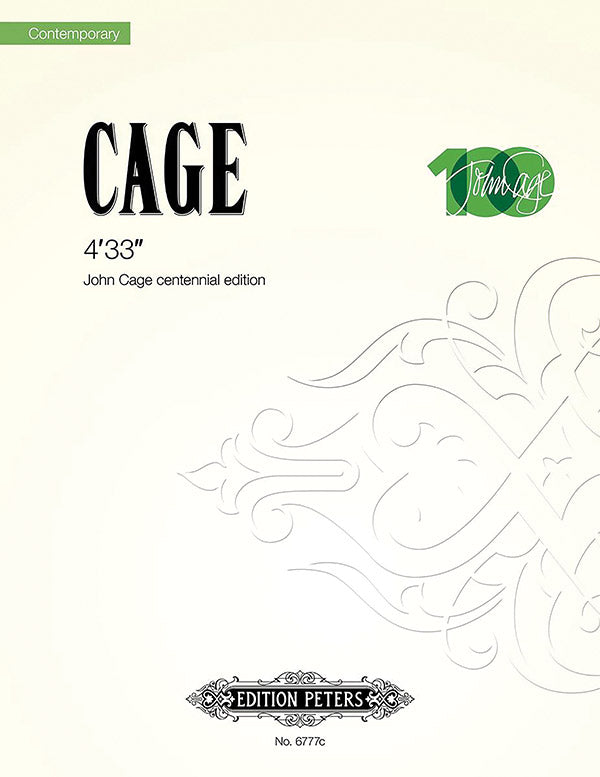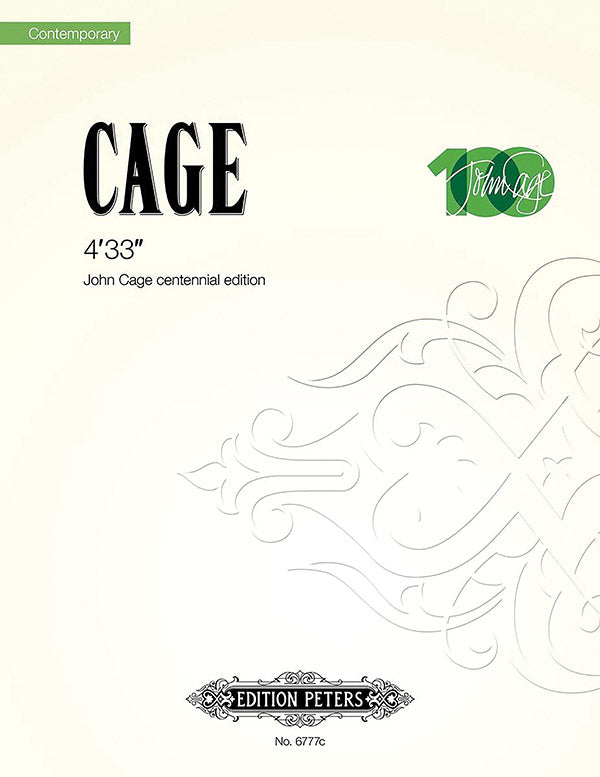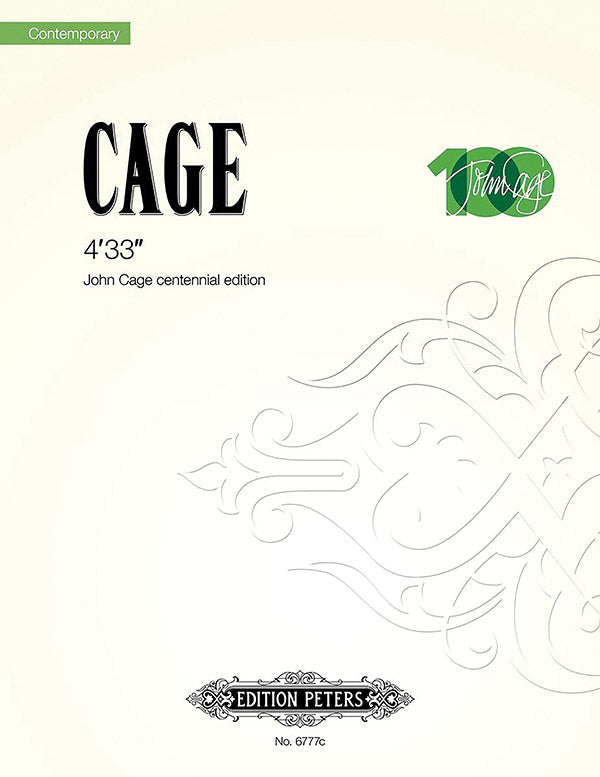John Cage
Cage: 4'33''
Centennial Edition
- Composer: John Cage (1912-1992)
- Instrumentation: Any Instrument
- Work: 4
- ISMN:
- Size: 9.1 x 11.9 inches
- Pages: 40
Description
4 '33" is a three-movement composition in which the performer makes no intentional sounds for the duration of the piece: four minutes and thirty three seconds. It was premiered in 1952, and has been generating controversy and debate ever since. The premiere of 4 '33" was given by David Tudor on August 29th, 1952, at Maverick Concert Hall, Woodstock, New York as part of a recital of contemporary piano music. The audience saw him sit at the piano and, to mark the beginning of the piece, close the keyboard lid. Some time later he opened it briefly, to mark the end of the first movement. This process was repeated for the second and third movements. The piece passed without a note being played - in fact, without Tudor (or anyone else) having made any deliberate sound as part of the piece. Tudor timed the three movements with a stopwatch, while turning the pages of the score.
Cage later spoke regarding the premiere and the audience's reaction: "They missed the point. There's no such thing as silence. What they thought was silence, because they didn't know how to listen, was full of accidental sounds. You could hear the wind stirring outside during the first movement. During the second, raindrops began pattering the roof, and during the third, people themselves made all kinds of interesting sounds as they talked or walked out."
"This edition of 4 '33" -- one of John Cage's most influential compositions -- is published in honor of the centennial of the composer's birth. It includes two of the extant versions: the 1952 proportional notation version (please see edition EP6777a) and the 1986 calligraphic "tacet" version (please see edition EP6777). An earlier typed edition of the "tacet" version, essentially the same as the calligraphic version, is also included as a frontispiece. This typed "tacet" version was used by C. F. Peters as the published edition from 1960, when Cage came to Peters, until 1986, when Cage created the calligraphic "tacet" version.
The manuscript of 4 '33" used by David Tudor for the premiere on August 29th, 1952 at Maverick Concert Hall in Woodstock, New York, is lost. This version used an entirely different notation system. Cage said it was composed " ... just like MUSIC OF CHANGES. That's how I knew how long it was when I added up the notes. It was done like a piece of music, except there were no sounds -- but there were durations." David Tudor reconstructed the manuscript in 1989. We have included his reconstruction in this volume, although it has been reduced to fit our format (the original was 9.3 x 12.5 inches). This reduction renders Tudor's durational marking "60 quarter notes = 2-1/2 cm." moot. We are grateful to the Getty Research Institute, Nancy Perloff, and Virginia Mokslaveskas for helping to make the publication of this reconstruction possible.
The final item in this collection is the text of a letter from John Cage to Helen Wolff, Christian Wolff's mother*. It was written in 1954, and concerns an imminent performance of 4 '33" by David Tudor. Cage is responding to a letter from Mrs Wolff and seeks to explain the piece." (Gene Caprioglio - Vice-President, C. F. Peters Corporation)
- Helen Wolff, in addition to having been the mother of Christian Wolff, was an editor and publisher, regarded by her colleagues in the international book world as the grande dame of letters. She and her husband founded Pantheon Books in 1942, and went on to publish works that included Boris Pasternak's Doctor Zhivago. in 1961, they left Pantheon to establish the imprint "A Helen and Kurt Wolff Book" at Harcourt Brace Jovanovich, and were particularly respected for bringing out translations of distinguished European authors. They were successful in acquiring important foreign books on account of Mrs Wolff's fluency in several languages (growing up in Macedonia, she, her sister, and their parents spoke German, Turkish, and Serbian). Among the authors with whom Mrs Wolff worked closely were Günter Grass, Umberto Eco, Max Frisch, Georges Simenon, Stanislaw Lem, and Amos Oz.
Publishers use a lot of words to describe what they sell, and we know it can be confusing. We've tried to be as clear as possible to make sure you get exactly what you are looking for. Below are descriptions of the terms that we use to describe the various formats that music often comes in.
Choral Score
A score for vocalists that only contains the vocal lines. The instrumental parts are not there for reference. Generally, cheaper than a vocal score and requires multiple copies for purchase.
Facsimile
Reproductions of the original hand-written scores from the composer.
Full Score
For ensemble music, this indicates that the edition contains all parts on a single system (there are not separate parts for each player). In larger ensembles, this is for the conductor.
Hardcover
Hardbound. Generally either linen-covered or half-leather.
Orchestral Parts
Similar to a wind set, this is a collection of parts. In the case of strings, the numbers listed are the number of copies included, though generally these are available individually (often with minimum quantities required).
Paperback
When publishers offer multiple bindings (e.g. hardcover) or study scores, this is the "standard" version. If you're planning to play the music, this is probably what you want.
Performance / Playing Score
A score of the music containing all parts on one system, intended for players to share. There are not separate parts for each player.
Set of Parts
For ensemble music, this indicates that there are separate individual parts for each player.
Solo Part with Piano Reduction
For solo pieces with orchestra, this is a version that contains a piano reduction of the orchestra parts. For piano pieces, two copies are typically needed for performance.
Study Score
A small (think choral size) copy of the complete score meant for studying, and not playing. They make great add-ons when learning concertos and small chamber works.
Vocal Score
A score prepared for vocalists that includes the piano/organ part or a reduction of the instrumental parts.
Wind Set
For orchestral music, this is a collection of wind and percussion parts. The specific quantities of each instrument are notated.
With Audio
In addition to the printed music, the edition contains recordings of the pieces. This may be an included CD, or access to files on the internet.
With / Without Fingering (Markings)
Some publishers prepare two copies - a pure Urtext edition that includes no fingering (or bowing) suggestions and a lightly edited version that includes a minimal number of editorial markings.




